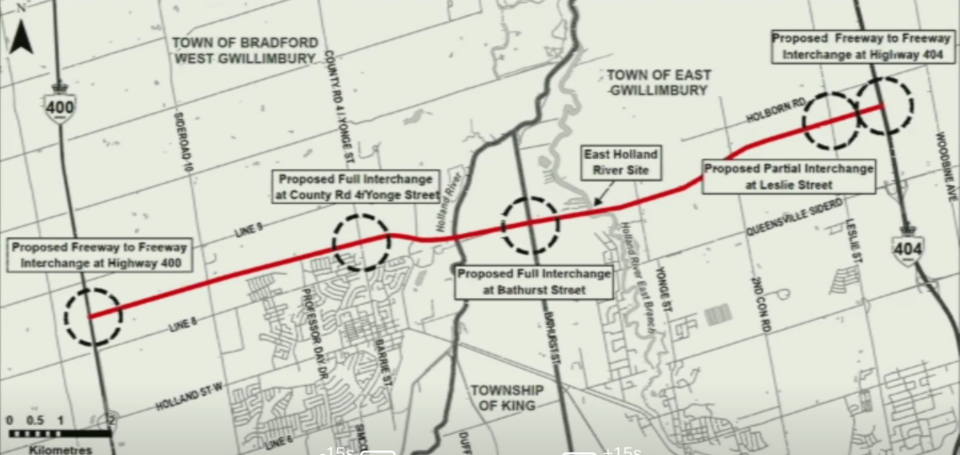Last week, seven environmental groups launched a lawsuit against the Federal Minister of Environment and Climate Change, Steven Guilbeault over his decision not to designate a Federal Impact Assessment for the Bradford Bypass, a 16.2 km four-lane link between Highways 400 and 404.
Organizations involved in the litigation include FROGS (Forbid Roads Over Green Spaces), Rescue Lake Simcoe Coalition, Ontario Nature, Western Canada Wilderness Committee, Wildlands League, Earthroots, and Environmental Defence, represented by Ecojustice.
The environmental organizations previously made two requests for a federal impact assessment on the proposed Bradford Bypass which the groups say would cut through the Greenbelt, the Holland Marsh provincially significant wetland, and the headwater rivers at the south end of the Lake Simcoe watershed. The federal government turned down both requests. The lawsuit challenges the government’s decision.
“Federal impact assessment can play an important ‘safety valve’ role by ensuring the full extent of environmental impacts are assessed before the project moves forward,” says Ian Miron, lawyer, Ecojustice.
Communications Advisor for The Impact Assessment Agency of Canada, Stéphane Perrault told BradfordToday that the Agency and Minister are aware of the lawsuit and the matter is now before the courts.
In February 2021, the former Minister of Environment and Climate Change, Jonathan Wilkinson, received a request to designate the Bradford Bypass Project. In May 2021, the Minister responded with reasons why the project does not warrant designation under the Impact Assessment Act.
One reason is that the project is already following regulatory review processes which allow the public to address their concerns under the Environmental Assessment Act, Endangered Species Act, Environmental Protection Act, Ontario Heritage Act, Ontario Water Resources Act, and Safe Drinking Water Act.
Another reason is the project is already required to comply with relevant provisions of federal legislation, including the Canadian Navigable Waters Act, the Fisheries Act and the Explosives Act.
The Minister considered the Agency’s analysis in making his decision. The 29-page analysis noted that between February 3, 2021, and April 27, 2021, the Minister received over 1,500 comments from members of the public on the Bradford Bypass Project, expressing concern with the project or requesting the project be designated, but that no federal lands are expected to be affected by the project. It concluded that the Agency sought and received input from relevant federal authorities and provincial ministries, local governments and potentially affected Indigenous groups in its analysis.
In May 2021, the Agency advised the Minister that the Bradford Bypass's potential for adverse effects would be limited through project design, the application of standard mitigation measures and through existing federal and provincial regulatory processes.
"Even though the Bradford Bypass Project is not subject to the Impact Assessment Act, it must comply with other federal legislation, including the Fisheries Act, the Canadian Navigable Waters Act, and the Explosives Act. Federal departments, including Fisheries and Oceans Canada, Transport Canada, and Environment and Climate Change Canada will also be participating in the provincial environmental assessment process and providing their expert advice," said Perrault.
The groups argue that Minister Guilbeault’s decision was not evidence-based and that he "unreasonably deferred" to the previous Minister’s decision.
“There are errors of fact in the Minister’s decision that cannot be allowed to go unchallenged,” says Tim Gray of Environmental Defence. “For the sake of Canada’s environment and the communities dependent on it, we must make sure that destructive projects, such as bulldozing a super-highway through one of Ontario’s largest wetlands, receive a proper and thorough review.”
When asked why the Highway 413 highway project, which will run through Peel, York and Halton regions, will require a Federal Impact Assessment while the Bradford Bypass does not, Perrault noted that former Minister Wilkinson concluded that the 413 project may cause adverse effects on the critical habitat of species at risk that may not be mitigated through project design or standard mitigation measures, or through existing legislative mechanisms. The Minister also took into account the public concerns related to these potential effects.
